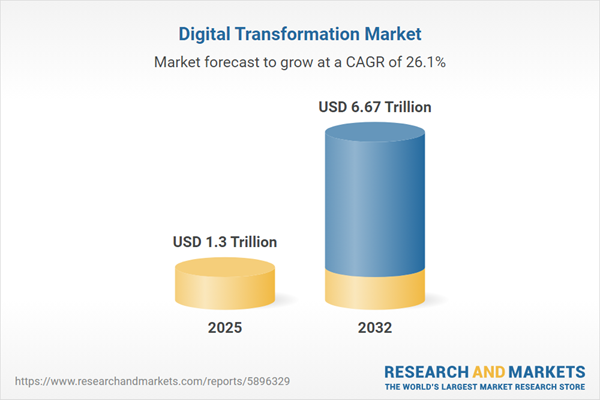Speak directly to the analyst to clarify any post sales queries you may have.
The digital transformation market continues to be reshaped by rapid innovation, organizational change, and evolving enterprise imperatives. This research equips senior decision-makers with the clarity and intelligence needed to lead in a dynamic competitive environment, highlighting actionable trends and influential factors driving successful transformation initiatives.
Market Snapshot: Digital Transformation Market Overview
The digital transformation market grew from USD 1.04 trillion in 2024 to USD 1.30 trillion in 2025 and is projected to grow at a CAGR of 26.05%, reaching USD 6.67 trillion by 2032. This expansion reflects enterprises’ increasing focus on integrating advanced technologies to improve operational agility, customer experience, and business model innovation. Demand is fueled by adoption across key verticals, emerging deployment models, and the strategic response to new regulatory frameworks. As organizations contend with continuous technological change, the competitive landscape is marked by accelerating investments, new collaboration patterns, and a need for resilient digital infrastructure.
Scope & Segmentation
- Product Type: Managed Services, Professional Services, Business Domain Transformation, Business Model Transformation, Business Process Transformation, Cloud Transformation
- Deployment: On-Cloud, On-Premises
- Organization Size: Large Enterprises, Small & Medium-Sized Enterprises
- Business Function: Accounting & Finance, Human Resources, IT & Operations, Marketing & Sales, Research & Development
- Industry Verticals: Automotive, E-Learning Solutions, Learning Analytics, Energy & Utilities, Fraud Detection, Mobile Banking, Border Security & Surveillance, Command & Control Systems, E-governance, Tax & Revenue Management, Health Analytics, Remote Patient Monitoring, Manufacturing, Audience Engagement & Personalization, Content Creation & Generation, eCommerce Platforms, Inventory Management Software, Point of Sale Systems, Telecommunications, Fleet Management, Intelligent Parking Systems, Traffic Management
- Geographic Regions: United States, Canada, Mexico, Brazil, Argentina, Chile, Colombia, Peru, United Kingdom, Germany, France, Russia, Italy, Spain, Netherlands, Sweden, Poland, Switzerland, United Arab Emirates, Saudi Arabia, Qatar, Turkey, Israel, South Africa, Nigeria, Egypt, Kenya, China, India, Japan, Australia, South Korea, Indonesia, Thailand, Malaysia, Singapore, Taiwan
Key Takeaways: Strategic Insights for Decision-Makers
- Adoption of digital transformation solutions accelerates business model reinvention and operational resilience across sectors.
- Cloud platforms, edge computing, and 5G foster real-time insights and scalable digital capabilities throughout the enterprise.
- Human-centered design, open innovation, and API-driven integrations are redefining how value is created and delivered.
- Decentralized organizational structures promote cross-functional collaboration, enabling rapid prototyping and experimentation.
- Industry verticals are leveraging tailored solutions to address unique regulatory, functional, and customer requirements.
- Regional priorities, from market maturity to regulatory environment, demand tailored strategies and localized deployments for lasting advantage.
Tariff Impact: Navigating New U.S. Trade Measures
The introduction of new U.S. tariffs on technology imports is altering procurement and investment dynamics for businesses engaged in digital transformation. These tariffs increase the cost of hardware and key components, prompting organizations to diversify vendors, shift toward onshore sourcing, or transition to software-defined architectures. Enterprises are now integrating sensitivity analyses into strategic roadmaps, balancing the need for agility with financial control as they adapt to evolving policy environments and manage supply chain risks.
Methodology & Data Sources
This report utilizes a robust research framework combining primary interviews with senior executives and secondary analysis of credible publications, databases, and regulatory documents. Rigorous data triangulation and expert validation ensure accuracy across segmentation, technology adoption, and geographic trends in the digital transformation market.
SEO Focus: Digital Transformation Market Leadership
The digital transformation market is driven by ongoing innovation in artificial intelligence, cloud-native platforms, and managed services, fostering both operational efficiency and customer-centricity. Leaders invest in platform-based business models, strategic alliances, and multi-disciplinary teams to respond quickly to market shifts and innovation cycles. As regional implementation patterns vary, aligning transformation strategies with localized requirements and industry-specific needs becomes vital for enterprises aiming for market leadership.
Why This Report Matters
- Enables senior leaders to align investments with the most impactful digital transformation strategies based on current industry trends and competitive benchmarks.
- Delivers clear segmentation insights and actionable regional analyses to guide the rollout of scalable, resilient digital solutions.
- Equips organizations to anticipate regulatory and geopolitical factors, proactively mitigating risk and capitalizing on opportunities.
Conclusion
This analysis provides senior decision-makers with a comprehensive understanding of market dynamics, segmentation, and strategic priorities. Equipped with these insights, organizations can navigate complexity and accelerate the impact of their digital transformation initiatives.
Additional Product Information:
- Purchase of this report includes 1 year online access with quarterly updates.
- This report can be updated on request. Please contact our Customer Experience team using the Ask a Question widget on our website.
Table of Contents
3. Executive Summary
4. Market Overview
7. Cumulative Impact of Artificial Intelligence 2025
Companies Mentioned
The companies profiled in this Digital Transformation market report include:- Accenture PLC
- AVEVA Group PLC
- Baidu, Inc.
- Cisco System Inc.
- Cognex Corporation
- Emerson Electric Co.
- Ericsson AB
- Google LLC by Alphabet, Inc.
- Hewlett Packard Enterprise Company
- Innominds Software India Private Limited
- Intel Corporation
- International Business Machines Corporation
- Kellton Tech Solutions Ltd.
- Microsoft Corporation
- NVIDIA Corporation
- Oracle Corporation
- Salesforce, Inc.
- SAP SE
- Siemens AG
- THALES group
- TIBCO Software, Inc
- Wipro Limited
- Yokogawa Electric Corporation
Table Information
| Report Attribute | Details |
|---|---|
| No. of Pages | 184 |
| Published | November 2025 |
| Forecast Period | 2025 - 2032 |
| Estimated Market Value ( USD | $ 1.3 Trillion |
| Forecasted Market Value ( USD | $ 6.67 Trillion |
| Compound Annual Growth Rate | 26.0% |
| Regions Covered | Global |
| No. of Companies Mentioned | 24 |









